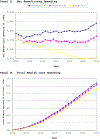Consequences of health trends and medical innovation for the future elderly
- PMID: 16186147
- PMCID: PMC6205231
- DOI: 10.1377/hlthaff.w5.r5
Consequences of health trends and medical innovation for the future elderly
Abstract
Recent innovations in biomedicine seem poised to revolutionize medical practice. At the same time, disease and disability are increasing among younger populations. This paper considers how these confluent trends will affect the elderly's health status and health care spending over the next thirty years. Because healthier people live longer, cumulative Medicare spending varies little with a beneficiary's disease and disability status upon entering Medicare. On the other hand, ten of the most promising medical technologies are forecast to increase spending greatly. It is unlikely that a "silver bullet" will emerge to both improve health and dramatically reduce medical spending.
Figures




References
-
- Buntin MJ, et al., “Increased Medicare Expenditures for Physicians’ Services: What Are the Causes?,” Inquiry 41, no. 1 (2004): 83–94. - PubMed
-
- Lubitz J, et al., “Health, Life Expectancy, and Health Care Spending among the Elderly,” New England Journal of Medicine 349, no. 11 (2003): 1048–1055. - PubMed
-
-
The MCBS sample consists of aged and disabled beneficiaries enrolled in Medicare. It attempts to interview each person twelve times over three years, regardless of whether he resides in the community or in an institution. Each fall a new panel is introduced with a target sample size of 12,000 respondents, and each summer a panel is retired.
-
-
- Crimmins EM, Saito Y and Reynolds SL, “Further Evidence on Recent Trends in the Prevalence and Incidence of Disability among Older Americans from Two Sources: The Lsoa and the Nhis,” The Journals of Gerontology: Series B, Psychological Sciences 52, no. 2 (1997): S59–71; - PubMed
- Manton KG, Corder L and Stallard E, “Chronic Disability Trends in Elderly United States Populations: 1982–1994,” Proceedings of the National Academy of Sciences of the United States of America 94, no. 6 (1997): 2593–2598; - PMC - PubMed
- Schoeni RF, Freedman VA and Wallace RB, “Persistent, Consistent, Widespread, and Robust? Another Look at Recent Trends in Old-Age Disability,” The Journals of Gerontology: Series B, Psychological Sciences 56, no. 4 (2001): S206–218. - PubMed
Publication types
MeSH terms
Grants and funding
LinkOut - more resources
Full Text Sources

